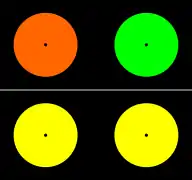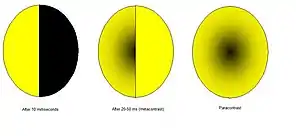Contrast effect
A contrast effect is the enhancement or diminishment, relative to normal, of perception, cognition or related performance as a result of successive (immediately previous) or simultaneous exposure to a stimulus of lesser or greater value in the same dimension. (Here, normal perception, cognition or performance is that which would be obtained in the absence of the comparison stimulus—i.e., one based on all previous experience.)
Perception example: A neutral gray target will appear lighter or darker than it does in isolation when immediately preceded by, or simultaneously compared to, respectively, a dark gray or light gray target. Cognition example: A person will appear more or less attractive than that person does in isolation when immediately preceded by, or simultaneously compared to, respectively, a less or more attractive person. Performance example: A laboratory rat will work faster, or slower, during a stimulus predicting a given amount of reward when that stimulus and reward are immediately preceded by, or alternated with, respectively, different stimuli associated with either a lesser or greater amount of reward.
Types

Simultaneous contrast
Simultaneous contrast, identified by Michel Eugène Chevreul, refers to the manner in which the colors of two different objects affect each other. The effect is more noticeable when shared between objects of complementary color.[1]
In the image here, the two inner rectangles are exactly the same shade of grey, but the upper one appears to be a lighter grey than the lower one due to the background provided by the outer rectangles.
There has been some debate over the degree to which simultaneous contrast is a physiological process caused by the connections of neurons in the visual cortex, or whether it is a psychological effect.[2] Both appear to have some effect. A possible source of the effect are neurons in the V4 area that have inhibitory connections to neighboring cells. The most likely evolutionary rationale for this effect is that it enhances edges in the visual field, thus facilitating the recognition of shapes and objects.

This is a different concept from contrast, which by itself refers to one object's difference in color and luminance compared to its surroundings or background.
Successive contrast
Successive contrast occurs when the perception of currently viewed stimuli is modulated by previously viewed stimuli.
For example, staring at the dot in the center of one of the two colored disks on the top row for a few seconds and then looking at the dot in the center of the disk on the same side in the bottom row makes the two lower disks appear to have different colors for a few moments, though they have the same color.

Metacontrast and paracontrast
Metacontrast and paracontrast involve both time and space. When one half of a circle is lit for 10 milliseconds (ms), it is at its maximal intensity. If the other half is displayed at the same time (but 20–50 ms later), there is a mutual inhibition: the left side is darkened by the right half (metacontrast), and the center may be completely obliterated. At the same time, there is a slight darkening of the right side due to the first stimulus (paracontrast).[3]
Domains
The contrast effect was noted by the 17th century philosopher John Locke, who observed that lukewarm water can feel hot or cold depending on whether the hand touching it was previously in hot or cold water.[4]
In the early 20th century, Wilhelm Wundt identified contrast as a fundamental principle of perception, and since then the effect has been confirmed in many different areas.[4] Contrast effects can shape not only visual qualities like color and brightness, but other kinds of perception, including the perception of weight.[5] One experiment found that thinking of the name "Hitler" led to subjects rating a person as more friendly.[6] Whether a piece of music is perceived as good or bad can depend on whether the music heard before it was unpleasant or pleasant.[7] For the effect to work, the objects being compared need to be similar to each other: a television reporter can seem to shrink when interviewing a tall basketball player, but not when standing next to a tall building. Furthermore, the contrast effect has been argued to apply to foreign policies of states. For example,[8] African countries have increasingly looked to China and India as opposed to the US, the EU and the World Bank because these Asian states have highlighted their lack of "interference" and "conditionality" in exchange for foreign aid and FDI.
See also
References
- Colour, Why the World Isn't Grey, Hazel Rossotti, Princeton University Press, Princeton, NJ, 1985, pp. 135–136. ISBN 0-691-02386-7.
- Kingdom, Fred (1997). "Simultaneous Contrast: The Legacies of Hering and Helmholtz". Perception. 26 (6): 673–677. doi:10.1068/p260673. PMID 9474338. S2CID 411796.
- "Eye, human". Encyclopædia Britannica. 2008. Encyclopædia Britannica 2006 Ultimate Reference Suite DVD.
- Kushner, Laura H. (2008). Contrast in judgments of mental health. p. 1. ISBN 978-0-549-91314-6. Retrieved 24 March 2011.
- Plous, Scott (1993). The psychology of judgment and decision making. McGraw-Hill. pp. 38–41. ISBN 978-0-07-050477-6. Retrieved 24 March 2011.
- Moskowitz, Gordon B. (2005). Social cognition: understanding self and others. Guilford Press. p. 421. ISBN 978-1-59385-085-2. Retrieved 24 March 2011.
- Popper, Arthur N. (30 November 2010). Music Perception. Springer. p. 150. ISBN 978-1-4419-6113-6. Retrieved 24 March 2011.
- Ndzendze, Bhaso. (23 March 2017). "Choosing 'the better evil'? The contrast effect and the relative nature of soft power". Modern Diplomacy. Retrieved 30 April 2017.
- Chevreul, Michel Eugène (1839). De la loi du contraste simultané des couleurs et de l'assortiment des objets colorés .- traduit en anglais par Charles Martel comme Les principes d’harmonie et de contraste des couleurs (1854)